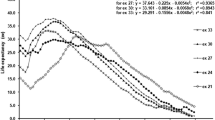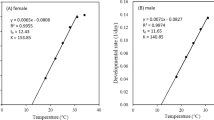Abstract
The effect of temperature on the development and fecundity of Sancassania polyphyllae fed on tissues of Polyphylla fullo larvae was studied at 15, 20, 25, 30, and 35 ± 1°C and 65 ± 10% RH in a dark incubator. Mean developmental period of immature stages decreased significantly with increasing temperatures from 15 to 30°C. Developmental periods at 30–35°C were not significantly different. The estimated lower developmental thresholds of the various immature stages ranged between 10.1 and 11.5°C. The thermal constant for the egg-to-female adult was 93.5 degree-days. The pre-oviposition, oviposition, and post-oviposition periods and female longevity were significantly longer at 15°C than at higher temperatures. Mean total and daily fecundity were the highest at 25°C, which were significantly different from those obtained at 15, 20 and 30°C. The net reproductive rate (R 0) was the highest at 25°C (588.3 ♀/♀). The longest mean generation time (T 0) occurred at 15°C (36 days) and the shortest occurred at 30°C (9.2 days). The highest intrinsic rate of increase (r m) for S. polyphyllae was observed at 25 (0.61 ♀/♀/day) and 30°C (0.62 ♀/♀/day).

Similar content being viewed by others
References
Birch LC (1948) The intrinsic rate of natural increase of an insect population. J Anim Ecol 17:15–26
Cakmak I, Ekmen ZI, Karagoz M, Hazir S, Kaya HK (2010) Development and reproduction of Sancassania polyphyllae (Acari: Acaridae) feeding on entomopathogenic nematodes and tissues of insect larvae. Pedobiologia 53:235–240
Campbell A, Frazer BD, Gilbert N, Gutierrez AP, Mackauer M (1974) Temperature requirements of some aphids and their parasites. J Appl Ecol 11:431–438
Cross EA, Bohart GE (1990) Notes on the life history of Sancassania boharti (Acari: Acaridae) and its relationship to the alkali bee, Nomia melanderi (Hymenoptera: Halictidae). J Kans Entomol Soc 63:603–610
Ekmen ZI, Hazir S, Cakmak I, Ozer N, Karagoz M, Kaya HK (2010) Potential negative effects on biological control by Sancassania polyphyllae (Acari: Acaridae) on an entomopathogenic nematode species. Biol Control. doi:10.1016/j.biocontrol.2010.05.004
Grewal PS, Koppenhöfer AM, Choo HY (2005) Lawn, turfgrass and pasture applications. In: Grewal PS, Ehlers RU, Shapiro-Ilan DI (eds) Nematodes as biocontrol agents. CABI Publishing, Wallingford, pp 115–146
Houck MA, OConnor BM (1991) Ecological and evolutionary significance of phoresy in the Astigmata. Annu Rev Entomol 36:611–636
Karagoz M, Gulcu B, Cakmak I, Kaya HK, Hazir S (2007) Predation of entomopathogenic nematodes by Sancassania sp. (Acari: Acaridae). Exp Appl Acarol 43:85–95
Kaya HK (2002) Natural enemies and other antagonists. In: Gaugler R (ed) Entomopathogenic nematology. CABI Publishing, Wallingford, pp 189–203
Kheradmand K, Kamali K, Fathipour Y, Goltapeh EM, Ueckermann EA (2007) Thermal requirement for development of Sancassania rodionovi (Acari: Acaridae) on Mushrooms. J Econ Entomol 100:1098–1103
Klimov PB, Lekveishvili M, Dowling APG, OConnor BM (2004) Multivariate analysis of morphological variation in two cryptic species of Sancassania (Acari: Acaridae) from Costa Rica. Ann Entomol Soc Am 97:322–345
Krantz GW, Walter DE (2009) A manual of acarology, 3rd edn. Texas Tech University Press, Lubbock
Krebs CJ (1998) Ecological methodology. Harper and Row Publ, New York
Laing JE (1968) Life history and life table of Phytoseiulus persimilis Athias-Henriot. Acarologia 10:578–588
McMurtry JA (1984) A consideration of the role of predators in the control of acarine pests. In: Griffiths DA, Brown CA (eds) Acarology VI, vol 1. Ellis Howard Ltd., New York, pp 109–121
Oseto CY, Mayo ZB (1975) A new species of Caloglyphus (Acarina: Acaridae) associated with Phyllophaga anxia (Coleoptera: Scarabaeidae). J Kans Entomol Soc 48:212–223
Rodriguez JG, Stepien ZA (1973) Biology and population dynamics of Caloglyphus berlesei (Michael) (Acarina: Acaridae) in xenic diet. J Kans Entomol Soc 46:176–183
SAS Institute (2009) JMP, a guide to statistical and data analysis, v. 8.02. SAS Institute Inc., Cary
Sell P (1988) Caloglyphus sp. (Acarina: Acaridae) an effective nematophagous mite on root-knot nematode (Meloidogyne spp.). Nematologica 34:246–248
SPSS (2004) SPSS v.13.0 for windows. SPSS Inc., Chicago
Woodring JP (1969) Observations on the biology of six species of acarid mites. Ann Entomol Soc Am 62:102–108
Zachvatkin AA (1941) Tyroglyphoid mites (Tyroglyphoidea), Fauna SSSR. Paukoobraznye 6:1–475 (in Russian)
Acknowledgments
The authors are grateful to Dr. Nickolas E. Palyvos for assisting with the statistical analysis and to Baris Gulcu and Karthik Raja Ramalingam for their assistance with the experiments. This study was supported by The Adnan Menderes University Research Foundation (ZRF—08009).
Author information
Authors and Affiliations
Corresponding author
Rights and permissions
About this article
Cite this article
Cakmak, I., Karagoz, M., Ipek Ekmen, Z. et al. Life history of Sancassania polyphyllae (Acari: Acaridae) feeding on dissected tissues of its phoretic host, Polyphylla fullo (Coleoptera: Scarabaeidae): temperature effects. Exp Appl Acarol 53, 41–49 (2011). https://doi.org/10.1007/s10493-010-9386-4
Received:
Accepted:
Published:
Issue Date:
DOI: https://doi.org/10.1007/s10493-010-9386-4




